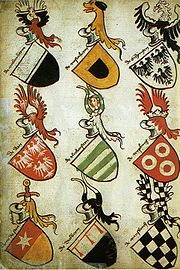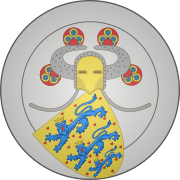Horned helmet


Horned helmets were worn by many people around the world. Headpieces mounted with animal horns or replicas were also worn since ancient history, as in the Mesolithic Star Carr Frontlets. These were probably used for religious ceremonial or ritual purposes, as horns tend to be impractical on a combat helmet. Much of the evidence for these helmets and headpieces comes from depictions rather than the items themselves.
Middle East
Horned hats have been used to signify deities in Mesopotamia, and later, as seen on the Victory Stele of Naram-Sin, kings as well. More horns signified higher importance.
Prehistoric Europe

Two bronze statuettes dated to the early 12th century BCE, the so-called "horned god" and "ingot god", wearing horned helmets, found in
A pair of bronze horned helmets, the
, (c. 800–500 BCE, now partially lost).The
Migration Period
Depicted on the Arch of Constantine, dedicated in 315 CE, are Germanic soldiers, sometimes identified as "Cornuti", shown wearing horned helmets. On the relief representing the Battle of Verona (312) they are in the first lines, and they are depicted fighting with the bowmen in the relief of the Battle of the Milvian Bridge.[3]
A depiction on a

Middle Ages
This section needs additional citations for verification. (June 2018) |

During the
In Asia


In pre-
Popular association with Vikings

The depiction of Vikings in horned helmets was an invention of the 19th-century
A 20th-century example is the Minnesota Vikings American football team, whose logo carries a horn on each side of the helmet. The comic strip character Hägar the Horrible and all male Vikings in the animated TV series Vicky the Viking are always depicted wearing horned helmets, as are numerous characters in the DreamWorks How to Train Your Dragon franchise and in The Lost Vikings video game series. Another popular culture depiction is the riff on Wagner's Der Ring des Nibelungen by Merrie Melodies in the Chuck Jones-directed cartoon What's Opera, Doc?, which depicts Elmer Fudd wearing a magical horned Viking helmet as he chases Bugs Bunny.
See also
Footnotes
- ^
Simpson (1979)Torslunda platebefore Anglo-Saxon and Swedish connections had been fully demonstrated.
- ^ Unfortunately, few Viking helmets survive intact. The small sample size cannot prove the point definitively, but they are all horn-free. ... Where there were gaps in the historical record, artists often used their imagination to reinvent traditions. Painters began to show Vikings with horned helmets, evidently inspired by Wagner's costume designer, Professor Carl Emil Doepler, who created horned helmets for use in the first Bayreuth production of "Der Ring des Nibelungen" in 1876.[11]
References
- ^ "Veksøhjelmene" (PDF). historiefaget.dk. Archived from the original (PDF) on 21 November 2016.
- ^ "Horned helmet". Explore / highlights. British Museum. Archived from the original on 27 May 2013. Retrieved 17 February 2013.
- ISBN 0-415-31199-3.
- ^ Bruce-Mitford, R. (1972). The Sutton Hoo Ship-Burial: A handbook (2nd ed.). London, UK. fig. 9 p. 30.
{{cite book}}: CS1 maint: location missing publisher (link) - ^ Davidson, H.R. Ellis (1967). Pagan Scandinavia. London, UK. plate 41.
{{cite book}}: CS1 maint: location missing publisher (link) - S2CID 163986460.
- ^ .
- ^ Sidgewick, J.B. (1939). "The mystery of the Long Man". Sussex County Magazine. Vol. 13. pp. 408–420.
- ^ "Odin from Levide - Medieval Histories". medievalhistories.com. 12 June 2014. Archived from the original on 26 October 2016. Retrieved 19 April 2018.
- ^ See the depiction of Wolfram von Eschenbach, and others, in the Codex Manesse.
- ^ a b c "Did Vikings wear horned helmets?". The Economist explains. 15 February 2013. Retrieved 17 February 2013.
- ^ "Did Vikings really wear horns on their helmets?". The Straight Dope. 7 December 2004. Retrieved 1 November 2008.
- ^ a b Frank, Roberta (2000). "The invention of the Viking horned helmet". International Scandinavian and Medieval Studies in Memory of Gerd Wolfgang Weber. pp. 199–208 – via Scribd.
- ISBN 0-8108-4859-7.
External links
- Frank, Roberta (2000). "The invention of the Viking horned helmet". International Scandinavian and Medieval Studies in Memory of Gerd Wolfgang Weber. pp. 199–208 – via Scribd.
- Additional non-Scribd version of Frank article
- "Did Vikings really wear horns on their helmets?". The Straight Dope. 7 December 2004.
